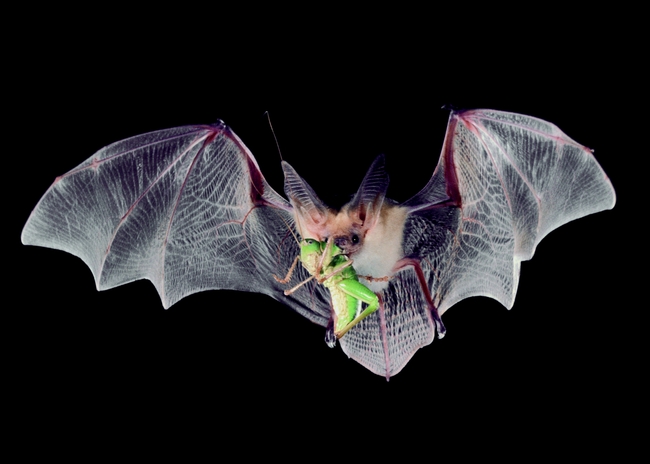Migrating bats may be resting, not sick, says UC bat expert
California is in the middle of the Pacific Flyway, a major north-south flyway for migratory birds, and also bats, that extends from Alaska to South America.
“Every autumn, migratory bats, such as the Mexican free-tailed bats, travel to their overwintering grounds in Southern California and Mexico, where there's plenty of bugs to eat; they come back each spring to raise their families,” said Rachael Long, a UC Cooperative Extension advisor who studies bats.
Bats are beneficial because they feed on insects, including mosquitoes and pests such as codling moths that damage fruit and nut crops. The economic value of bats for pest control on farms has been estimated by some studies to exceed $23 billion per year. Long, who serves Sacramento, Solano and Yolo counties, is studying the value of bats for pest control in walnut orchards.
In the city of Davis, officials recently warned people to stay away from bats after bats found on the UC Davis campus tested positive for rabies. Long agrees with the warning, but worries that it might also result in healthy bats being killed.
“This is most unfortunate for people and bats, but not a surprise at this time of year. Right now, thousands of bats are flying through our great Central Valley, migrating south for the winter, just like ducks and geese, so there's a higher chance of contact,” she said “We just don't see bats as much because they are flying at night, using the stars, earth's magnetic field, and landscapes to navigate.”
Their journey south is lengthy, from as far north as Washington state to Mexico, and exhausting, so bats need to rest along the way.
“Sometimes you'll see one or more tucked up in the corner of your house, such as under an eave,” Long said. “If so, use this as an opportunity to share with others the amazing life of a bat that can fly over a thousand miles to their overwintering grounds and back again in the spring. Leave them alone, let them rest, and they will fly away after they've rested and recovered.”
If you have to move a bat, she notes you should wear gloves and not handle a bat with bare hands because they will bite in self-defense.
“If you find a bat on the ground, place a box over the bat and using a piece of card, slip it under, then gently and carefully slide the bat into the box,” Long said. “Place the box at 4 to 5 feet off the ground and open it (bats usually can't take off from the ground). The bat can then crawl out of the box in its own time and fly away.”
“If the bat does not fly away within 30 minutes, it is probably sick or injured. In this case, contact a wildlife rescue unit in your area.”
Long noted that animal control officers have to euthanize bats to test for rabies.
“The bat may be perfectly healthy, just tired,” she said. “If no people or pets have obviously touched the bat, you can call a wildlife rescue organization. If in doubt, call animal control.”
If a bat does have rabies, Long said, “Rabies dies within five to 10 minutes after the bat dies.”
For more information on the benefits of bats, see Long's post in UC ANR's Green Blog, “Bats in the Belfry? No, Bats in Walnut Orchards” at //ucanr.edu/blogs/blogcore/postdetail.cfm?postnum=17395.




Posted by Leslie Kruth on November 11, 2016 at 8:12 PM